We will be undertaking an 8-day field project off Hawai‘i Island starting April 13, 2019, funded through a grant from the Office of Naval Research to Wildlife Computers and Marine Ecology and Telemetry Research (MarEcoTel). This will be our 18th year of working off the island, and our first field project there in 2019. The primary goal for this work is the deployment and recovery of a new version of the Sound and Motion Recording Telemetry (SMRT) tag on short-finned pilot whales, being developed by Wildlife Computers, Dr. Russ Andrews (MarEcoTel), and Dr. Mark Johnson (Univ. of St. Andrews). We first deployed these tags during our April 2018 field effort. As usual, we’ll also be working with all species of odontocetes we encounter, trying to obtain photos for our Hawai‘i photo-identification catalogs (13 species), and we may also collect biopsy samples for studies of genetics, toxicology, and hormone chemistry of several species, breath samples (collected via drone or pole) for studies of the respiratory microbiome, and, if we encounter them, deploy LIMPET satellite tags on false killer whales, to examine their spatial use around the islands.
The research crew for this project will include Russ Andrews from Marine Ecology and Telemetry Research, as well as Colin Cornforth, Brittany Guenther, Jordan Lerma, and Daniel Webster as well as guest appearances from Shelby Yahn and Annabelle Wall, all from Cascadia. If you want some background information on our work in Hawai‘i we published a paper on our first 13 years of surveys and a pdf is available here
End of project update
Over the last week we had 22 encounters with 8 different species, took ~12,500 photos for our photo-ID catalogs, deployed 4 of the SMRT tags and 6 LIMPET tags (all on short-finned pilot whales), collected one octopod, one biopsy sample (from a Cuvier’s beaked whale), and five breath samples (all from short-finned pilot whales). Overall it was a very successful project. As of April 21st all four SMRT tags were still attached (these tags have to be recovered to get most of the data back), so Russ Andrews will be remaining around in order to recover the tags when they come off.
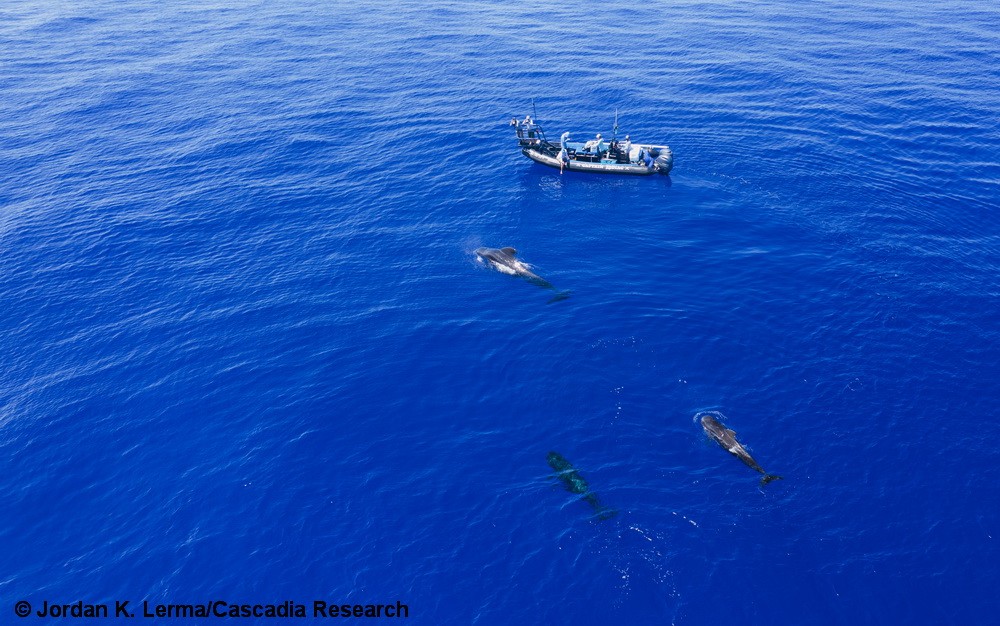
Our research boat working with a group of short-finned pilot whales, taken from a drone that we are using for breath sampling and photogrammetry.
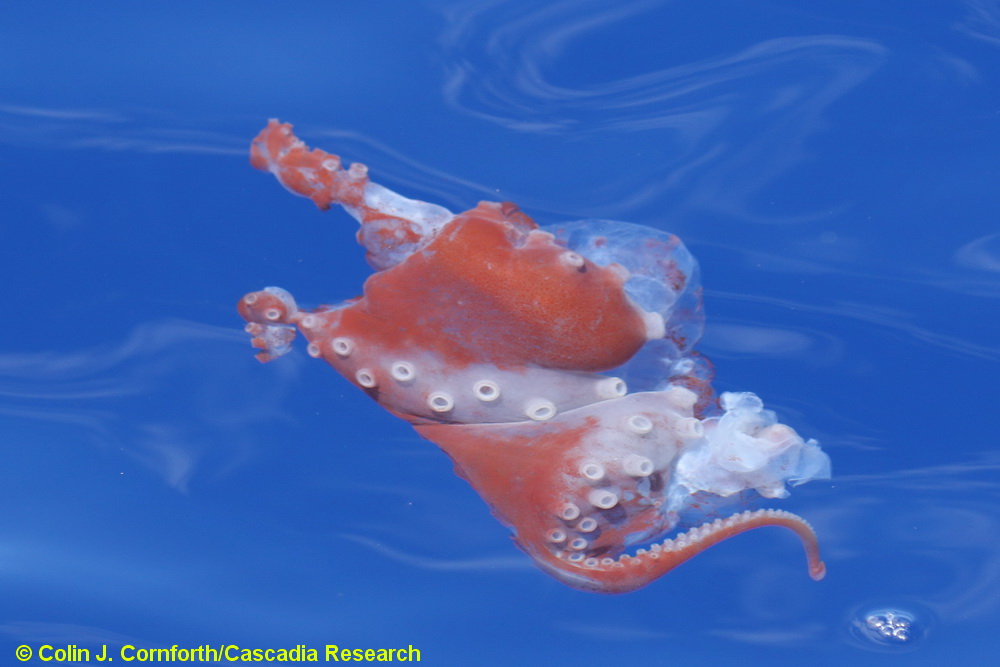
A pelagic octopod, likely Alloposus mollis. We collect dead floating squid and octopus to learn more about the prey species available to both deep-diving cetaceans and seabirds. For more information on this aspect of our work check out the poster entitled “Diurnal Occurrence of Dead Mesopelagic Fish and Squid at the Sea Surface and their Importance as a Previously Unrecognized Predictable Food Resource for Oceanic Marine Birds”

A pair of short-finned pilot whales from the resident eastern community. We had nine encounters with pilot whales this trip, with individuals from four or five different social groups. With over 8,000 photos from these encounters, we should be able to identify most or all of the individuals present.

Deploying a drone with a petri dish on top to sample the exhaled plume from a short-finned pilot whale, as part of a study of the respiratory microbiome of this species.

Our NMFS research permit allows for briefly flying a drone as low as 6′ above odontocetes for the purpose of breath sampling. This drone is on its way to a short-finned pilot whale for sampling.
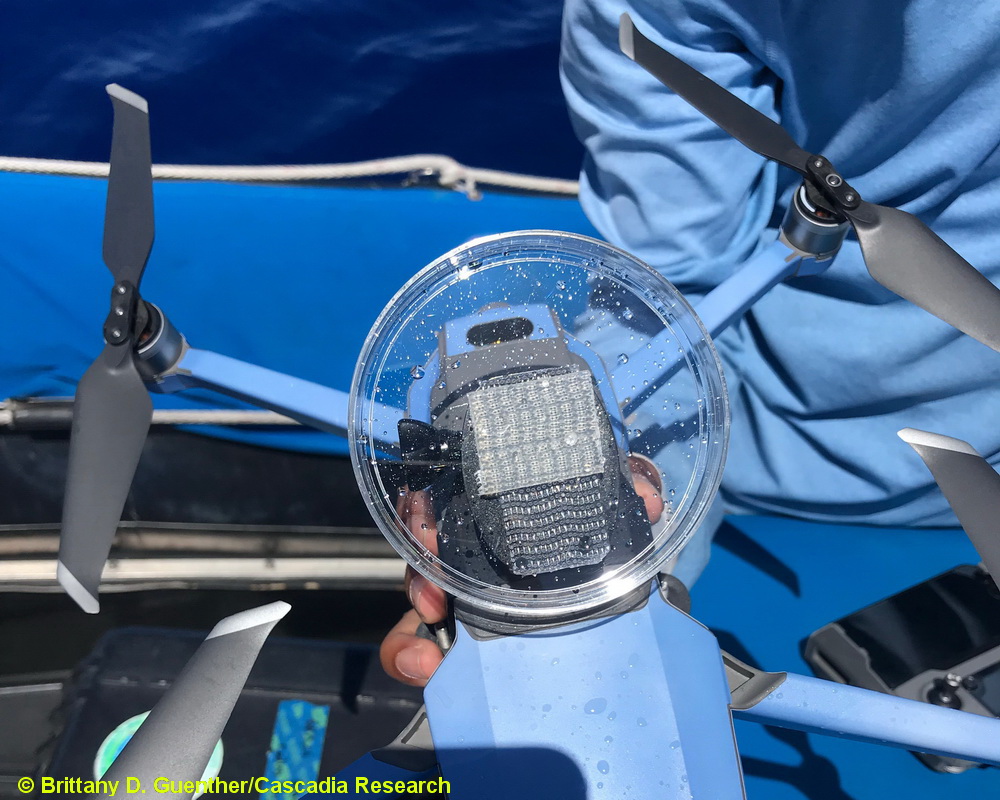
The same drone after it flew through the exhaled plume from a pilot whale, showing lots of droplets on the petri dish.
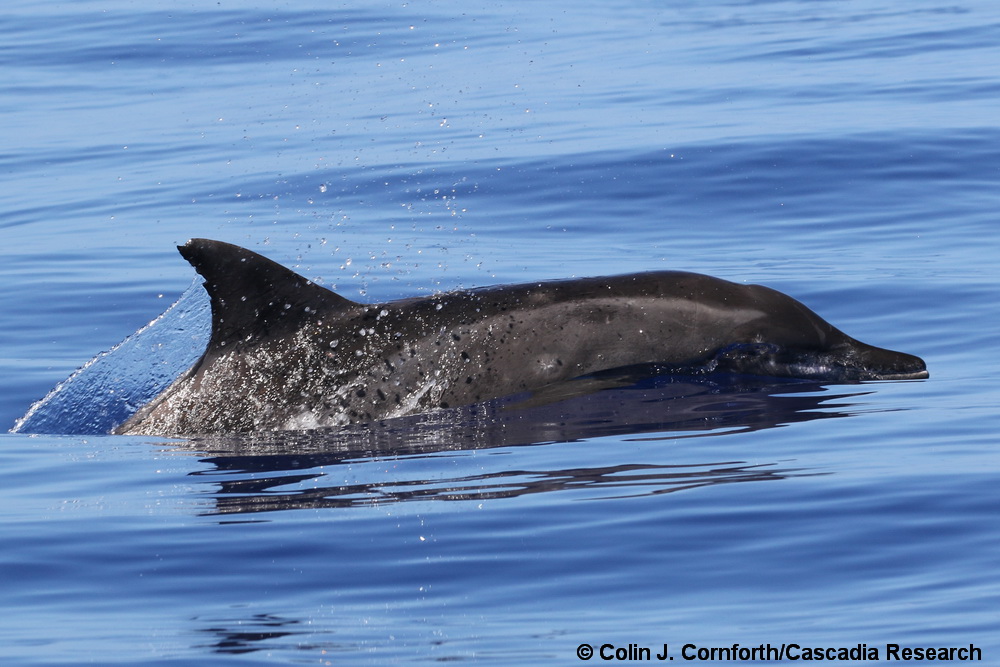
We had four encounters with rough-toothed dolphins this trip, and were able to get ID photos of a number of individuals to compare to our photo-ID catalog of this species. There is a resident population of rough-toothed dolphins off the island that we’ve been studying since our first field effort here in 2002. For more information on the species check our rough-toothed dolphin species page.
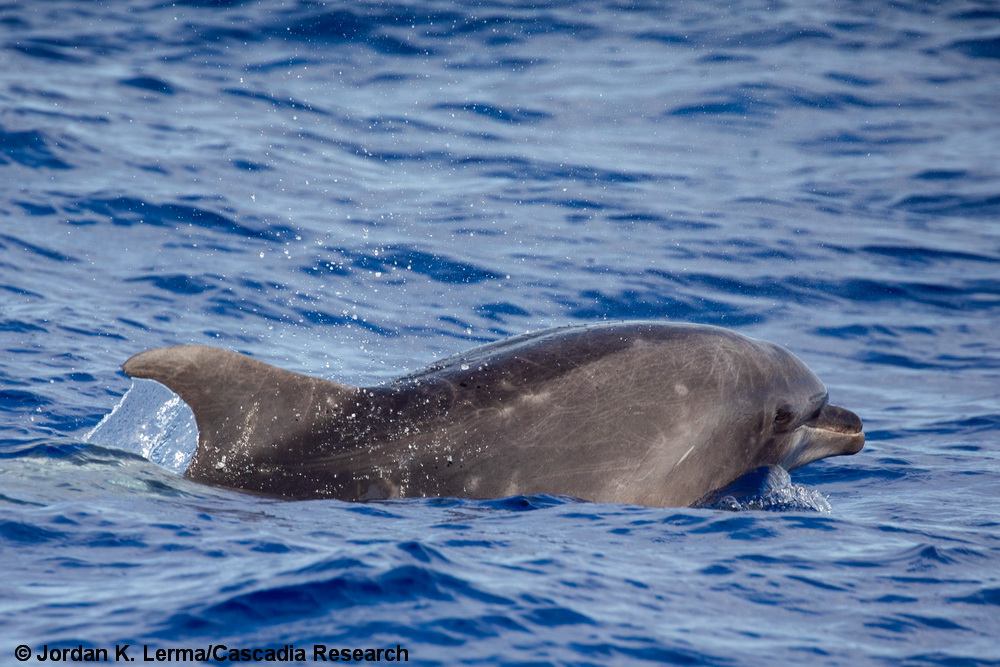
We had two encounters with bottlenose dolphins and were able to get identification photos to add to our long-term photo-ID catalog. There is a small resident population of this species off the island, so it is likely that most of the individuals are already in our catalog.
April 17th update
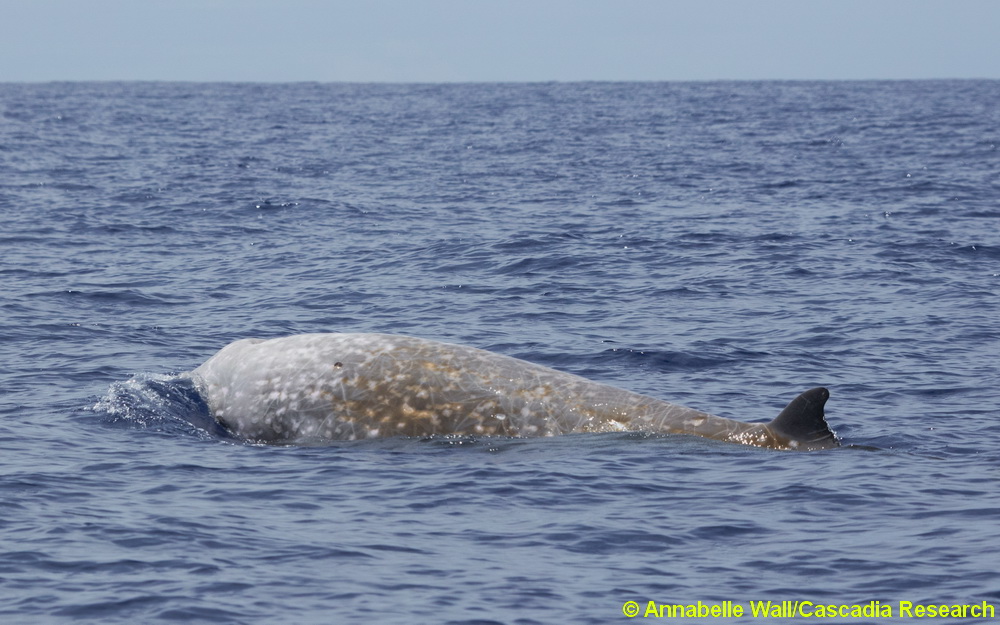
Over the last couple of days we’ve encountered another new species for the trip, with sightings of two different groups of Cuvier’s beaked whales! The individual above is HIZc005 in our photo-identification catalog, an adult male first documented off the island in September 2004, and last seen in November 2004, almost 15 years ago! A little bit about the coloration of this individual. As they age, Cuvier’s beaked whales get white heads and the older they get the more the white extends backwards on the animal. The browner coloration farther back is likely primarily diatoms, growing on the skin. All the oval white (or yellowish, when covered with diatoms) spots are from cookie-cutter shark bites. This individual also has lots of linear scars, which are typical of adult male Cuvier’s beaked whales. The group seen April 16th contained five individuals – while we haven’t yet identified all of them, one other present is HIZc052 in our catalog, a likely adult female that was first documented in November 2006, and which was last seen in November 2017, with sightings in five different years in between.
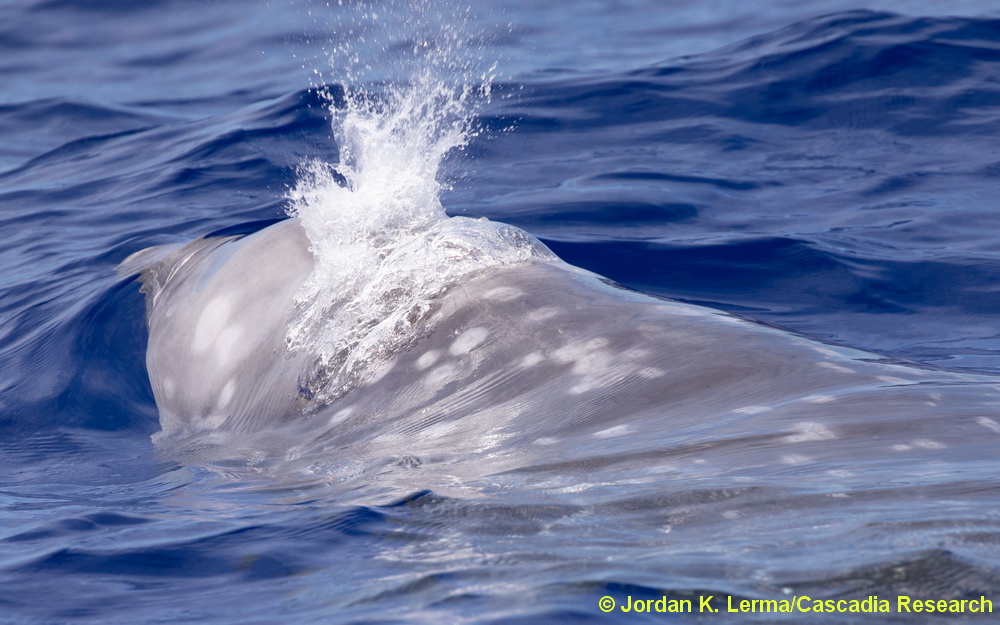
This individual appears to be an adult female, an adult based on the number of cookie-cutter scars, and a female based on the lack of linear scars. These individuals are all part of the small resident population of this species.

We’ve also had good success with pilot whales, our primary species for this project, deploying several of the Wildlife Computers SMRT tags (seen here on the right side of this individual, tagged April 16th), as well as several LIMPET tags.

An adult male short-finned pilot whale spyhopping, April 17th. This photo nicely shows the squared-off head of the Naisa form of short-finned pilot whale, found both in Hawai‘i and off southern Japan. Check out our pilot whale web page for more information on this species in Hawai‘i.
April 15th update

Over the last two days we’ve had encounters with five different species of cetaceans off Kona, albeit with no more sightings of pilot whales. On April 15th we encountered a group of about 200 melon-headed whales, with several rough-toothed dolphins mixed in. Given their location (off south Kona in deep water) these individuals are likely part of the Hawaiian Islands population of melon-headed whales, rather than members of the Kohala resident population.

Melon-headed whales are found in the largest average group sizes of any cetacean in Hawaiian waters – the largest we’ve encountered had an estimated 800 individuals.
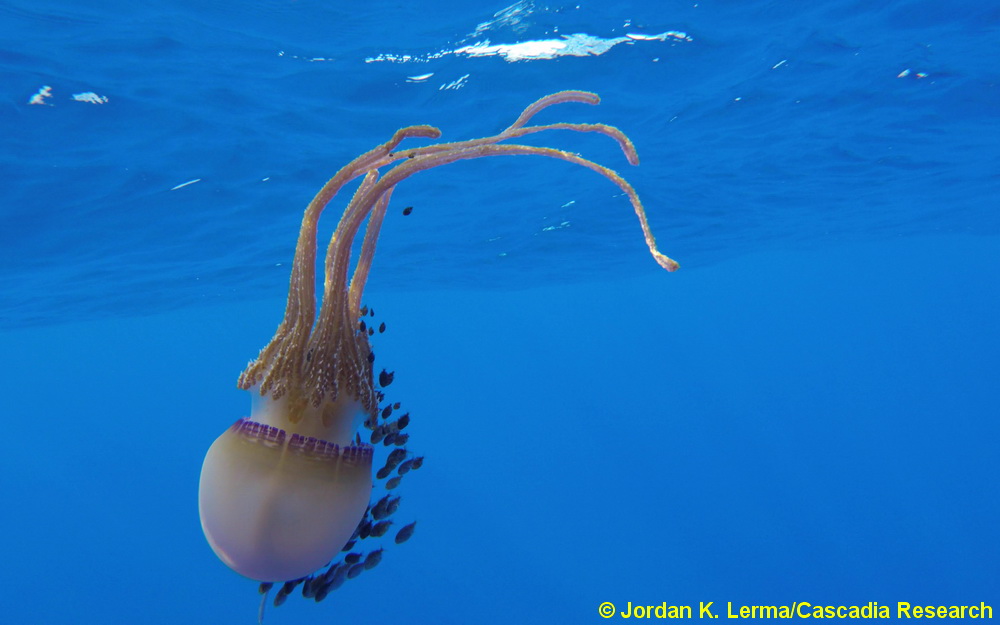
We also document other unusual species when out on the water – this jellyfish is likely Thysanostoma loriferum. According to Wyatt Patry from the Monterey Bay Aquarium, this species is full of zooxanthellae so is effectively “solar powered”
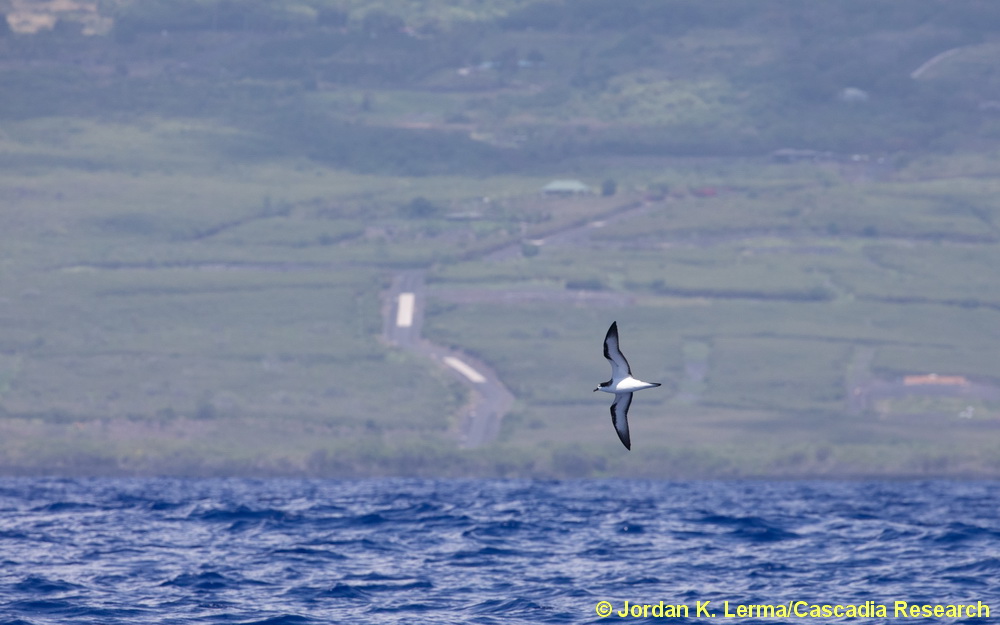
We also record seabirds – this is an endemic Hawaiian Petrel, off south Kona April 15th. For more information on our seabird observations check out our Hawaiian seabird page
April 13th update

While there were no opportunities to deploy SMRT tags on day one of the project, it was a productive day, with encounters with three groups of pilot whales, two of which were known resident groups for the island. The highlight for the day (at least for some of the crew) was a lone adult male Blainville’s beaked whale that was repeatedly breaching. Breaching is not common for this species; in 59 prior encounters with this species we’ve only seen breaching on a few occasions, and only with one or two instances within an encounter.

A close up of the head of the adult male Blainville’s beaked whale, showing the bizarre head morphology. On the left side of the whale’s lower jaw you can see an erupted tooth with several stalked barnacles (probably Conchoderma sp.). The tooth on the right is completely covered with stalked barnacles. In adult males of this species the lower jaws are strong arched, so that the teeth project above the upper jaw, and are used by the males for fighting with other males. The red oval wound on the left side of the head is a healing wound from a cookie cutter shark bite – you can also see a number of completely healed cookie-cutter shark bite wounds (the pale white oval shapes), some long white scars from fighting with other males, and one small set of four parallel scars that appear to be from an interaction with a dolphin!

This photo shows the head of the Blainville’s beaked whale just as it breaks the surface
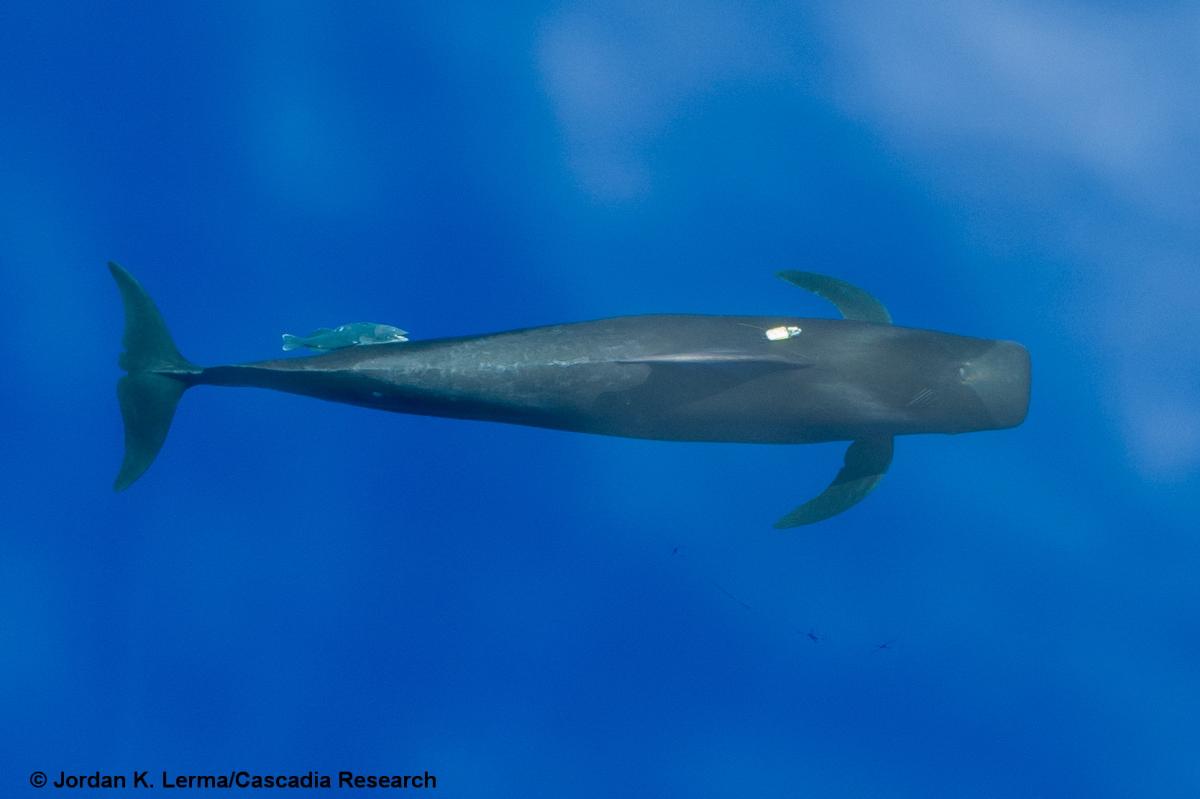
The photo above is from our April 2018 field project, showing an adult male short-finned pilot whale with one of the Wildlife Computers SMRT tags (the yellow tag just below the dorsal fin), as well as a large remora on the whale’s peduncle
Photos taken NMFS Scientific Research Permit No. 20605. All photos are copyrighted and should not be used without permission (contact Robin Baird at rwbaird (at) cascadiaresearch.org for permission).
Updates from our previous field projects can be found here.
Like us on Facebook if you want to receive notices of when information is posted and updates on other Cascadia projects.